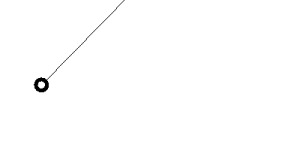By Defne Dinler
When do you get stubborn? With yourself? With others?
I notice that I feel stubborn when someone randomly gives me advice without my asking for it. It triggers a part of me that says, “Who do you think you are that you think you’re better than me.”
I grew up in a culture that put women down, a lot. Is that the cause of my trigger, of my stubbornness? I don’t know. I know I have an insecure part of me that can feel like I’m less than others, not good enough. I get to be a work in progress, always caring for that wounded part.
When a wound is triggered, our nervous system goes into survival mode. As a result, our mind and emotions can go into a split and we often end up at one of two polar extremes—collapse or intensity. When we collapse into the pain, we often feel and believe it. We accept the voices that say, “I am less than”, “I am not enough”, “I am less important”, “less wise” … etc. Or we become enraged, fueled by this immense energy to protect our vulnerable and most likely younger wounded self from the pain. It says, “I am worthy, I am special. I am important. I have wisdom as well.” Rage is big, there’s massive energy in rage. And yet, its motivation can be healthy. Rage is there to defy the part that believes in the worthlessness, to give the fuel, the force to stand tall and fight, to be intense rather than collapse.
However, living in a state of either extreme—collapse or rage—is not healthy, not helpful; in fact, it can be completely exhausting. The intensity of either state cuts us off from connection, from interaction with the self and with others. We can neither self-regulate nor co-regulate our affective state with someone else, someone we trust and believe in. We need the in-between. If believing the wound—what we learned growing up about ourselves as a person and as someone in relationship with other people—is at one end of a pendulum swing, and rage is at the other end of it, what happens when we pass through the midline as we swing back and forth? What is the healthy balance to move with? 
I’m not saying not to feel the collapse and the rage. What I am saying is that we can allow ourselves to feel both ends of the pendulum’s reach because they are there, they are part of who we are in the moment. We can find our essence through our defenses and our pain. But when we react from the end points of the pendulum, when we become stuck in one extreme or the other, our behaviors and affect states become unhealthy. We lose connection with ourselves and with those in our lives who are there to support us, to love, us, to accept us as we are.
When someone starts lecturing me, if I rage at them and tell them to shut up, or get rude, I’m breaking a connection. I’m creating pain for the other while trying to protect myself. If I withdraw and don’t say anything, I’m deleting myself from the relationship, which also hurts the connection. A relationship doesn’t exist if I don’t exist. When I care about a person and the connection, I have an opportunity to practice self-care and healthy connection.
Stubborn is a rage reaction. I can be stubborn at times. I used to be so stubborn that even if the advice given was what I needed or wanted, I ignored it. I know that place well. Now, with all the therapeutic work I’ve done on my way to awakening, I can still feel a pinch of rage, just as it starts to boil, and I am aware of it. The difference is that I am aware. Awareness gives me the chance to see that the other person is not doing something deliberately to put me down. I don’t have to take the “lecturing” personal. It may be their habit, their defense, which may very well come from a place of “I know better than you”, which serves to make them feel better. I don’t have to fall for that trap. I don’t have to take on that belief system. It doesn’t belong to me.
Having awareness helps me take care of my pain. When we have awareness, we have choice. When we have choice, we have much more power! If someone is giving me advice and/or lecturing me and it feels well intentioned, even if I didn’t ask for it, being aware in the moment gives me a chance to stay curious and listen. It also gives me a chance to set a boundary and let the person know that I appreciate advice when I ask for it, and if I haven’t asked that just being listened to, feeling heard feels most caring. If someone is lecturing with the mask and attitude of “I am better than you”, again, I don’t have to be mean. I can still set a boundary from a calm place as opposed to becoming destructive. I can let them know I don’t appreciate that attitude, or tone of voice, or again, being told what to do/feel etc. If they continue, I get to set a stronger boundary. Maybe I don’t continue to be around this person.
Until I feel into that place of utter stubbornness, I can’t truly be peaceful with the trigger though. The more I stay curious to my stubbornness, to its power, to its pleasure, to its limitations, the more I get to know myself. Stubborn is a somewhat socially accepted way of being rageful and passive aggressive. There can be great pleasure in it because we are saying “no” to anything coming from the outside. We get to stand our ground however healthy or destructive it is. We get to feel the power of our rage without losing control to it.
What if we felt into the pain of the stubbornness? Maybe it’s a younger place, a younger self who may have felt like he/she didn’t get to have a say as a little kid, who wanted to do things his/her own way. That little kid that did not get to feel like an individual. Maybe that younger self felt powerless around the adults who determined how to dress, how to eat, how to stand—proper posture and all of that—or how long or short your hair had to be. That young part most likely wanted to scream and say “no” but had to comply to fit in, to be accepted. That little kid needed caregivers to survive. As you grow up, it can turn into a place of “I determine what my life looks like, what I eat, what I wear, what I study, where I work, my weight, how my body looks, whom I pick as my partner”. There’s a lot of power in digging your heels, tightening your body, locking your jaw, creating a wall fortified by rage’s energy. But that insistence can translate into an extreme, into being stubborn without room for movement in any direction.
As humans we are good at stretching things to their edges. The power of stubbornness can come with great survival skills and great destructive energy. It can help you be much healthier in ways if your stubbornness helps you defy other rigid ways you had to grow up. It might help you eat healthier, follow the career you are passionate about, be with the one you love. It can also keep you in a limiting rigid place because of shutting down every other option that your environment offers. Eating disorders can come from that stubborn place that felt powerless at times. Note that not all people that struggle with eating disorders are stubborn. They can correlate.
As you look within, I invite you to reflect on your edges, your places of flexibility and rigidness, play with your edges. Where does your stubbornness serve you, where does it not? We look at stubbornness as a negative because it is an intensified boundary. Where has this intensified boundary supported you in your life? Where does it hinder your enjoyment of life? As you notice it, what do you want to do about it? Do you want change? Are you happy with where you are with it? Do you wish you were more stubborn? What a great place to explore! Staying curious to your relationship to your stubbornness can be a most supportive way of owning your power while staying in connection to others. What a great healing place.
Defne Dinler is a licensed somatic psychotherapist who uses action oriented therapeutic modalities to help clients reach their goals. She specializes in trauma, anxiety and relationship issues. She has a private practice in Denver and has been a guest lecturer at Naropa University where she got her M.A from. Defne has a therapy dog, Aria, who loves to assist in sessions and come to groups.  Images retrieved from
Images retrieved from
.http://www.newkidscenter.com/Dealing-with-a-Stubborn-Child.html
http://pink-panthers-radio.blogspot.com/2013/02/sine-cosine-applications.html








